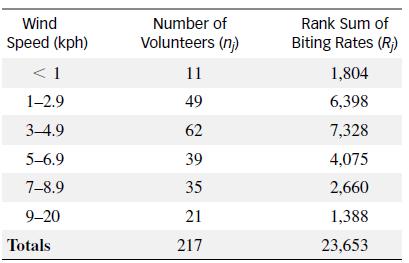Refer to Exercise 15.63. The effect of wind speeds in kilometers per hour (kph) on the biting
Question:
Refer to Exercise 15.63. The effect of wind speeds in kilometers per hour (kph) on the biting rate of the flies on Stanbury Island, Utah, was investigated by exposing samples of volunteers to one of six wind speed conditions. The distributions of the biting rates for the six wind speeds were compared using the Kruskal–Wallis test. The rank sums of the biting rates for the six conditions are shown in the next table.

a. The researchers reported the test statistic as H = 35.2. Verify this value.
b. Find the rejection region for the test using α = .01.
c. Make the proper conclusions.
d. The researchers reported that the p-value of the test is less than .01. Does this value support your inference in part c? Explain.
Data from Exercise 15.63
The biting rate of a particular species of fly was investigated in a study reported in the Journal of the American Mosquito Control Association (Mar. 1995). Biting rate was defined as the number of flies biting a volunteer during 15 minutes of exposure. This species of fly is known to have a median biting rate of 5 bites per 15 minutes on Stanbury Island, Utah. However, it is theorized that the median biting rate is higher in bright, sunny weather. To test this theory, 122 volunteers were exposed to the flies during a sunny day on Stanbury Island. Of these volunteers, 95 experienced biting rates greater than 5.
Step by Step Answer:

Statistics For Engineering And The Sciences
ISBN: 9781498728850
6th Edition
Authors: William M. Mendenhall, Terry L. Sincich





